Business Research Methodology: Construction Waste Management in India
VerifiedAdded on 2020/05/16
|17
|3349
|260
Report
AI Summary
This research report presents a comprehensive analysis of construction waste management in India, focusing on the effective utilization of recycled aggregates. The study aims to identify economical methods for waste management, analyze factors influencing the application of recycled aggregates, and assess their impact on the construction industry's cost and sustainability. The research employs an abductive approach, utilizing case studies and combined research strategies to gather and analyze both primary and secondary data. The research plan outlines a one-year timeline, detailing the steps from formulating research aims to data analysis. The report also references relevant research and explains the chosen methodology, including the sequence of methods and the rationale behind selecting the abductive system of inquiry and the combined methods approach, to ensure the research objectives are met.
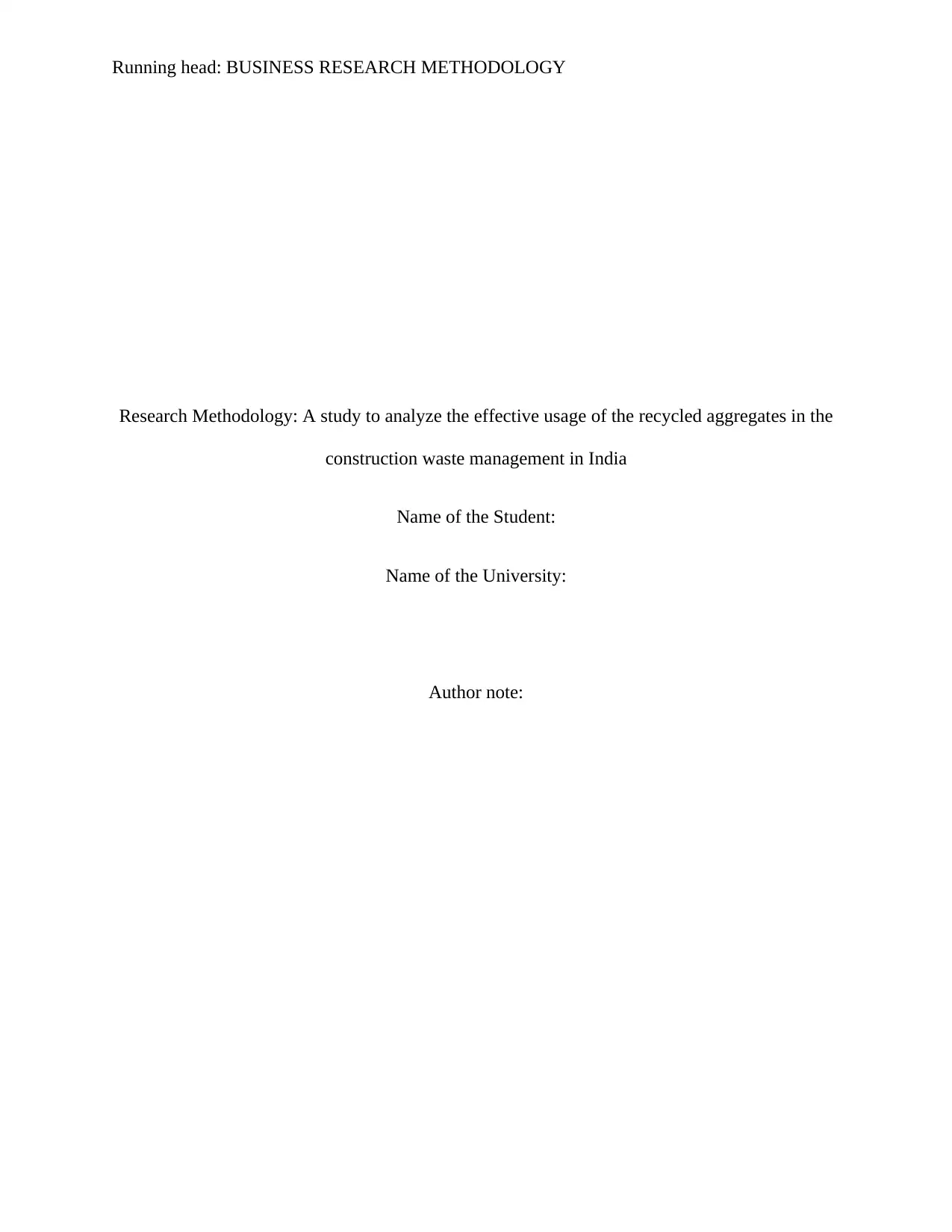
Running head: BUSINESS RESEARCH METHODOLOGY
Research Methodology: A study to analyze the effective usage of the recycled aggregates in the
construction waste management in India
Name of the Student:
Name of the University:
Author note:
Research Methodology: A study to analyze the effective usage of the recycled aggregates in the
construction waste management in India
Name of the Student:
Name of the University:
Author note:
Paraphrase This Document
Need a fresh take? Get an instant paraphrase of this document with our AI Paraphraser
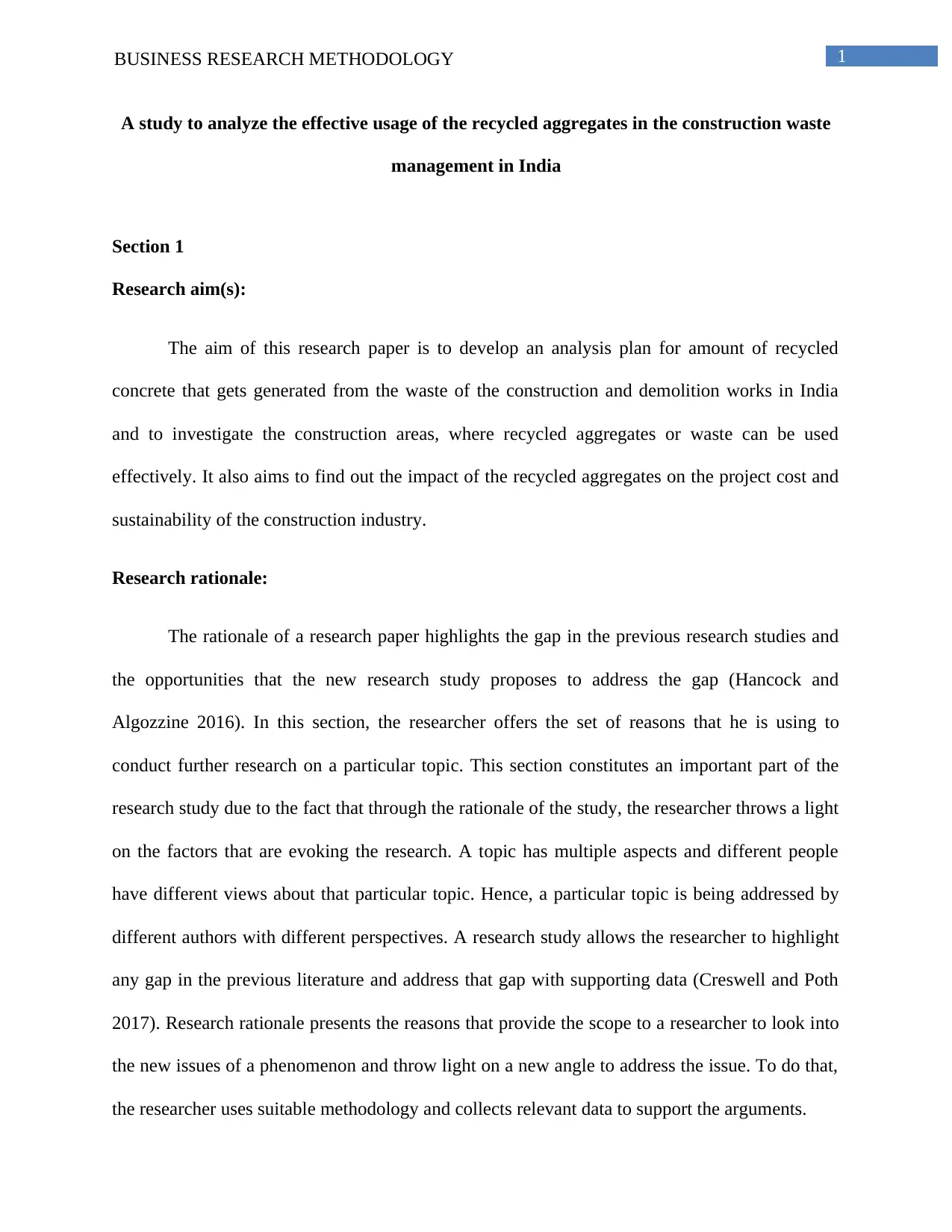
1BUSINESS RESEARCH METHODOLOGY
A study to analyze the effective usage of the recycled aggregates in the construction waste
management in India
Section 1
Research aim(s):
The aim of this research paper is to develop an analysis plan for amount of recycled
concrete that gets generated from the waste of the construction and demolition works in India
and to investigate the construction areas, where recycled aggregates or waste can be used
effectively. It also aims to find out the impact of the recycled aggregates on the project cost and
sustainability of the construction industry.
Research rationale:
The rationale of a research paper highlights the gap in the previous research studies and
the opportunities that the new research study proposes to address the gap (Hancock and
Algozzine 2016). In this section, the researcher offers the set of reasons that he is using to
conduct further research on a particular topic. This section constitutes an important part of the
research study due to the fact that through the rationale of the study, the researcher throws a light
on the factors that are evoking the research. A topic has multiple aspects and different people
have different views about that particular topic. Hence, a particular topic is being addressed by
different authors with different perspectives. A research study allows the researcher to highlight
any gap in the previous literature and address that gap with supporting data (Creswell and Poth
2017). Research rationale presents the reasons that provide the scope to a researcher to look into
the new issues of a phenomenon and throw light on a new angle to address the issue. To do that,
the researcher uses suitable methodology and collects relevant data to support the arguments.
A study to analyze the effective usage of the recycled aggregates in the construction waste
management in India
Section 1
Research aim(s):
The aim of this research paper is to develop an analysis plan for amount of recycled
concrete that gets generated from the waste of the construction and demolition works in India
and to investigate the construction areas, where recycled aggregates or waste can be used
effectively. It also aims to find out the impact of the recycled aggregates on the project cost and
sustainability of the construction industry.
Research rationale:
The rationale of a research paper highlights the gap in the previous research studies and
the opportunities that the new research study proposes to address the gap (Hancock and
Algozzine 2016). In this section, the researcher offers the set of reasons that he is using to
conduct further research on a particular topic. This section constitutes an important part of the
research study due to the fact that through the rationale of the study, the researcher throws a light
on the factors that are evoking the research. A topic has multiple aspects and different people
have different views about that particular topic. Hence, a particular topic is being addressed by
different authors with different perspectives. A research study allows the researcher to highlight
any gap in the previous literature and address that gap with supporting data (Creswell and Poth
2017). Research rationale presents the reasons that provide the scope to a researcher to look into
the new issues of a phenomenon and throw light on a new angle to address the issue. To do that,
the researcher uses suitable methodology and collects relevant data to support the arguments.
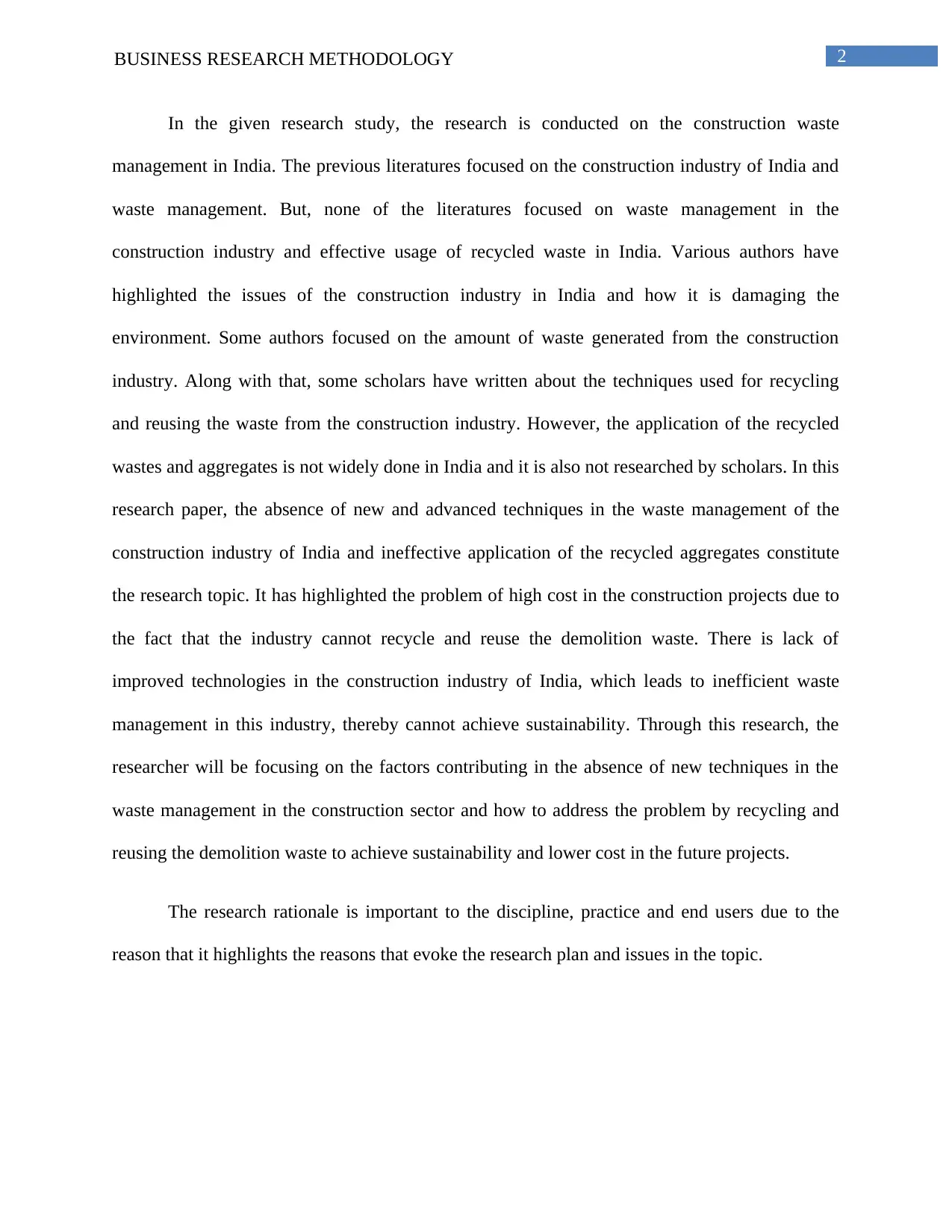
2BUSINESS RESEARCH METHODOLOGY
In the given research study, the research is conducted on the construction waste
management in India. The previous literatures focused on the construction industry of India and
waste management. But, none of the literatures focused on waste management in the
construction industry and effective usage of recycled waste in India. Various authors have
highlighted the issues of the construction industry in India and how it is damaging the
environment. Some authors focused on the amount of waste generated from the construction
industry. Along with that, some scholars have written about the techniques used for recycling
and reusing the waste from the construction industry. However, the application of the recycled
wastes and aggregates is not widely done in India and it is also not researched by scholars. In this
research paper, the absence of new and advanced techniques in the waste management of the
construction industry of India and ineffective application of the recycled aggregates constitute
the research topic. It has highlighted the problem of high cost in the construction projects due to
the fact that the industry cannot recycle and reuse the demolition waste. There is lack of
improved technologies in the construction industry of India, which leads to inefficient waste
management in this industry, thereby cannot achieve sustainability. Through this research, the
researcher will be focusing on the factors contributing in the absence of new techniques in the
waste management in the construction sector and how to address the problem by recycling and
reusing the demolition waste to achieve sustainability and lower cost in the future projects.
The research rationale is important to the discipline, practice and end users due to the
reason that it highlights the reasons that evoke the research plan and issues in the topic.
In the given research study, the research is conducted on the construction waste
management in India. The previous literatures focused on the construction industry of India and
waste management. But, none of the literatures focused on waste management in the
construction industry and effective usage of recycled waste in India. Various authors have
highlighted the issues of the construction industry in India and how it is damaging the
environment. Some authors focused on the amount of waste generated from the construction
industry. Along with that, some scholars have written about the techniques used for recycling
and reusing the waste from the construction industry. However, the application of the recycled
wastes and aggregates is not widely done in India and it is also not researched by scholars. In this
research paper, the absence of new and advanced techniques in the waste management of the
construction industry of India and ineffective application of the recycled aggregates constitute
the research topic. It has highlighted the problem of high cost in the construction projects due to
the fact that the industry cannot recycle and reuse the demolition waste. There is lack of
improved technologies in the construction industry of India, which leads to inefficient waste
management in this industry, thereby cannot achieve sustainability. Through this research, the
researcher will be focusing on the factors contributing in the absence of new techniques in the
waste management in the construction sector and how to address the problem by recycling and
reusing the demolition waste to achieve sustainability and lower cost in the future projects.
The research rationale is important to the discipline, practice and end users due to the
reason that it highlights the reasons that evoke the research plan and issues in the topic.
⊘ This is a preview!⊘
Do you want full access?
Subscribe today to unlock all pages.

Trusted by 1+ million students worldwide
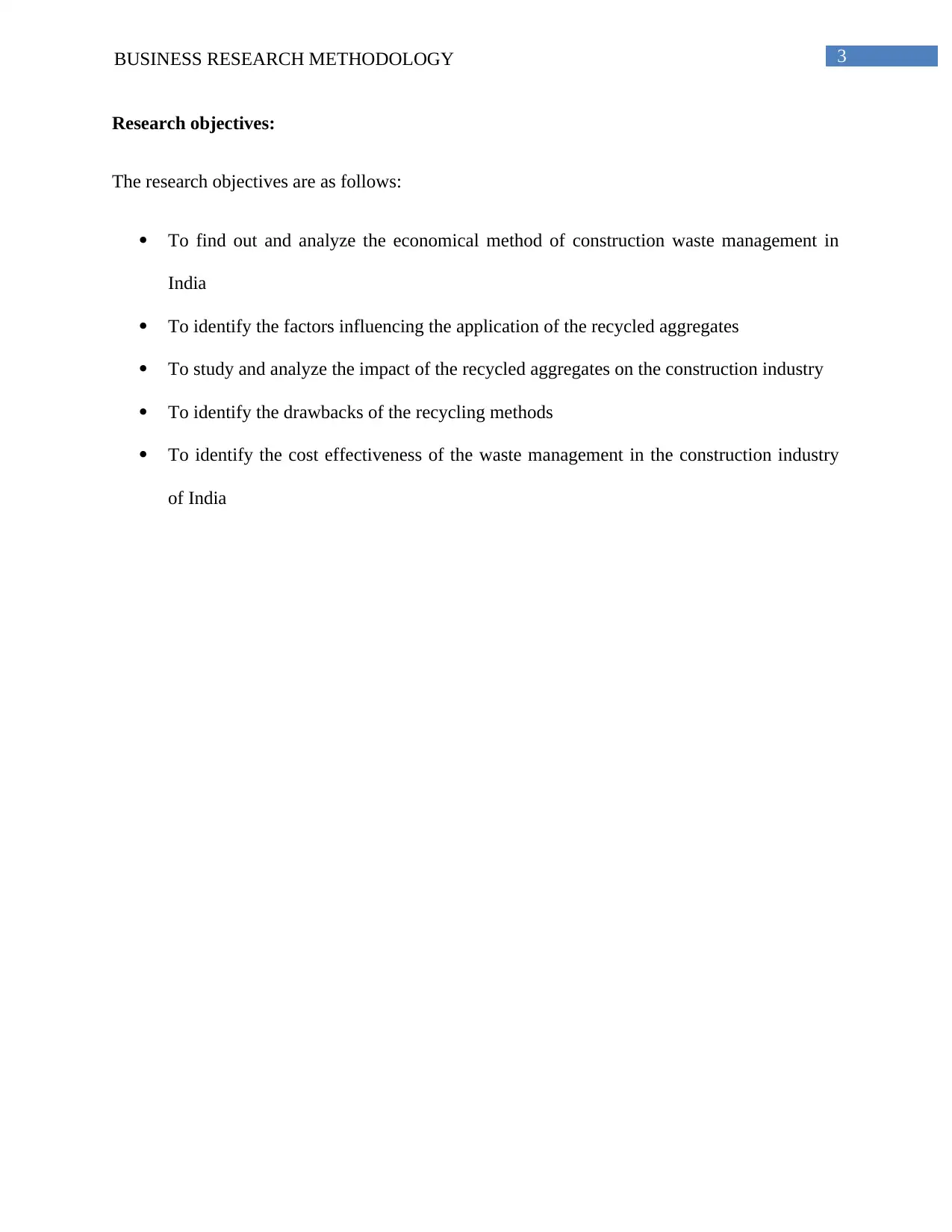
3BUSINESS RESEARCH METHODOLOGY
Research objectives:
The research objectives are as follows:
To find out and analyze the economical method of construction waste management in
India
To identify the factors influencing the application of the recycled aggregates
To study and analyze the impact of the recycled aggregates on the construction industry
To identify the drawbacks of the recycling methods
To identify the cost effectiveness of the waste management in the construction industry
of India
Research objectives:
The research objectives are as follows:
To find out and analyze the economical method of construction waste management in
India
To identify the factors influencing the application of the recycled aggregates
To study and analyze the impact of the recycled aggregates on the construction industry
To identify the drawbacks of the recycling methods
To identify the cost effectiveness of the waste management in the construction industry
of India
Paraphrase This Document
Need a fresh take? Get an instant paraphrase of this document with our AI Paraphraser
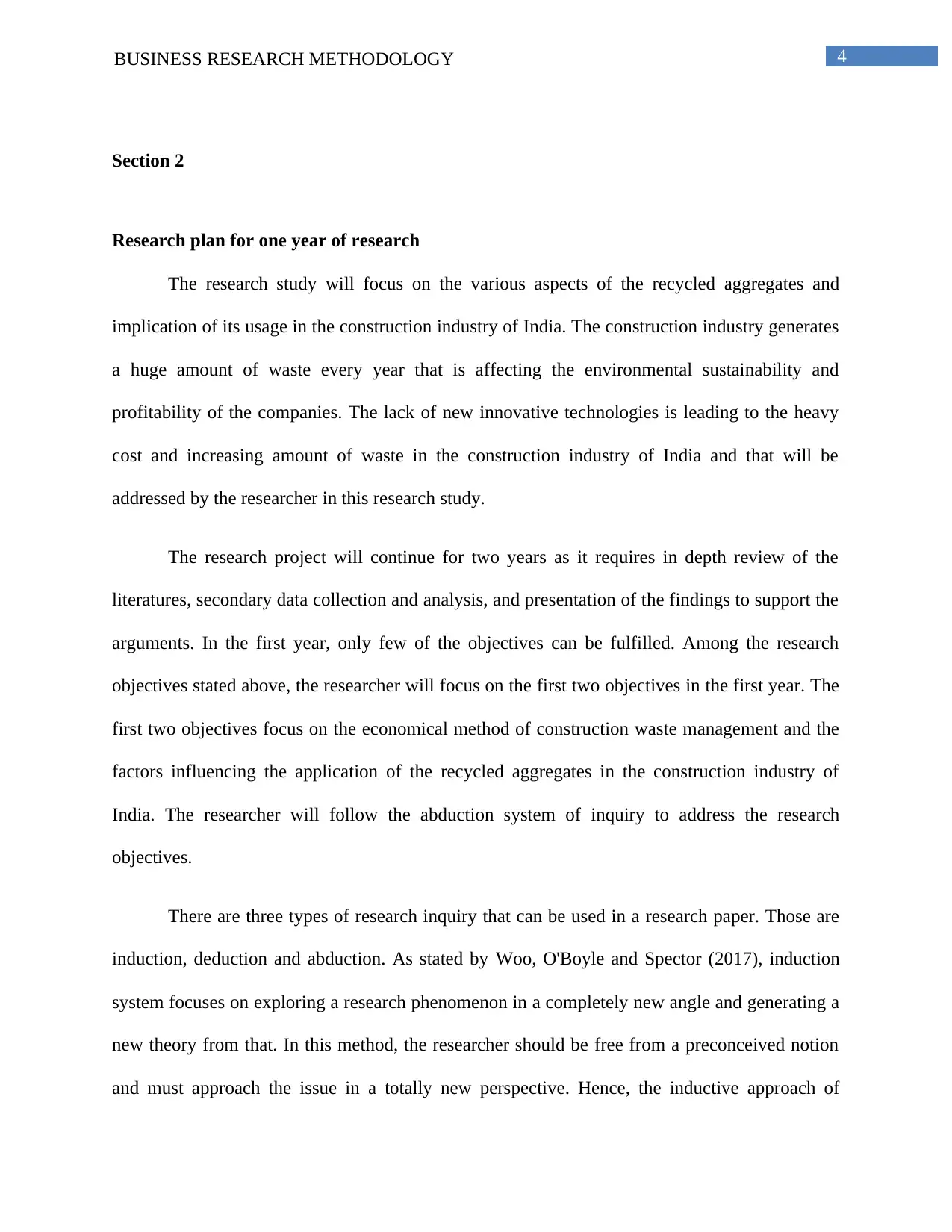
4BUSINESS RESEARCH METHODOLOGY
Section 2
Research plan for one year of research
The research study will focus on the various aspects of the recycled aggregates and
implication of its usage in the construction industry of India. The construction industry generates
a huge amount of waste every year that is affecting the environmental sustainability and
profitability of the companies. The lack of new innovative technologies is leading to the heavy
cost and increasing amount of waste in the construction industry of India and that will be
addressed by the researcher in this research study.
The research project will continue for two years as it requires in depth review of the
literatures, secondary data collection and analysis, and presentation of the findings to support the
arguments. In the first year, only few of the objectives can be fulfilled. Among the research
objectives stated above, the researcher will focus on the first two objectives in the first year. The
first two objectives focus on the economical method of construction waste management and the
factors influencing the application of the recycled aggregates in the construction industry of
India. The researcher will follow the abduction system of inquiry to address the research
objectives.
There are three types of research inquiry that can be used in a research paper. Those are
induction, deduction and abduction. As stated by Woo, O'Boyle and Spector (2017), induction
system focuses on exploring a research phenomenon in a completely new angle and generating a
new theory from that. In this method, the researcher should be free from a preconceived notion
and must approach the issue in a totally new perspective. Hence, the inductive approach of
Section 2
Research plan for one year of research
The research study will focus on the various aspects of the recycled aggregates and
implication of its usage in the construction industry of India. The construction industry generates
a huge amount of waste every year that is affecting the environmental sustainability and
profitability of the companies. The lack of new innovative technologies is leading to the heavy
cost and increasing amount of waste in the construction industry of India and that will be
addressed by the researcher in this research study.
The research project will continue for two years as it requires in depth review of the
literatures, secondary data collection and analysis, and presentation of the findings to support the
arguments. In the first year, only few of the objectives can be fulfilled. Among the research
objectives stated above, the researcher will focus on the first two objectives in the first year. The
first two objectives focus on the economical method of construction waste management and the
factors influencing the application of the recycled aggregates in the construction industry of
India. The researcher will follow the abduction system of inquiry to address the research
objectives.
There are three types of research inquiry that can be used in a research paper. Those are
induction, deduction and abduction. As stated by Woo, O'Boyle and Spector (2017), induction
system focuses on exploring a research phenomenon in a completely new angle and generating a
new theory from that. In this method, the researcher should be free from a preconceived notion
and must approach the issue in a totally new perspective. Hence, the inductive approach of

5BUSINESS RESEARCH METHODOLOGY
research is concerned with generation of new theory from the findings (Mojtahed et al. 2014).
According to Shaw (2017), the deductive approach focuses on testing an already established
theory. The emphasis is put on the causality and the application of an established theory to test
the research phenomenon is important. Hence, inferencing from the relevant theory is essential in
this type of research approach (Sekaran and Bougie 2016). Apart from that, there is another type
of system inquiry, called abduction. As stated by Ary et al. (2018), abductive research approach
involves inferencing the most likely event from a set of observations. In other words, the
researcher logically inferences a possible event from some observations around the research
issue. Usually, the researcher starts with a potential explanation of the research topic and if it is
not proved to be true following from the evidences collected, then he moves on to the next one
and start gathering evidences (Bernard 2017).
In majority of the research studies, the deductive approach is usually adopted. The
researcher chooses a research topic and frames problem statement or research hypothesis based
on that. Then he tests the hypothesis on the basis of a relevant theory or answers the research
questions with the help of some suitable theory(s) (Voss, Johnson and Godsell 2015). However,
in the research projects for architecture and construction, the researchers prefer to use the
abduction system of inquiry. In the given research, the researcher will choose the abductive
approach of research. In this study, the researcher has planned to gather relevant data about the
construction waste management in India, the amount and properties of recycled aggregates,
problems in the application of the recycled aggregates of the construction and demolition waste
and its cost effectiveness. After collecting the data, the researcher will make a proposition about
the solution and will present the insights. He will again present alternative propositions and will
do the critical analysis based on the theories, will be testing the data using statistical analytical
research is concerned with generation of new theory from the findings (Mojtahed et al. 2014).
According to Shaw (2017), the deductive approach focuses on testing an already established
theory. The emphasis is put on the causality and the application of an established theory to test
the research phenomenon is important. Hence, inferencing from the relevant theory is essential in
this type of research approach (Sekaran and Bougie 2016). Apart from that, there is another type
of system inquiry, called abduction. As stated by Ary et al. (2018), abductive research approach
involves inferencing the most likely event from a set of observations. In other words, the
researcher logically inferences a possible event from some observations around the research
issue. Usually, the researcher starts with a potential explanation of the research topic and if it is
not proved to be true following from the evidences collected, then he moves on to the next one
and start gathering evidences (Bernard 2017).
In majority of the research studies, the deductive approach is usually adopted. The
researcher chooses a research topic and frames problem statement or research hypothesis based
on that. Then he tests the hypothesis on the basis of a relevant theory or answers the research
questions with the help of some suitable theory(s) (Voss, Johnson and Godsell 2015). However,
in the research projects for architecture and construction, the researchers prefer to use the
abduction system of inquiry. In the given research, the researcher will choose the abductive
approach of research. In this study, the researcher has planned to gather relevant data about the
construction waste management in India, the amount and properties of recycled aggregates,
problems in the application of the recycled aggregates of the construction and demolition waste
and its cost effectiveness. After collecting the data, the researcher will make a proposition about
the solution and will present the insights. He will again present alternative propositions and will
do the critical analysis based on the theories, will be testing the data using statistical analytical
⊘ This is a preview!⊘
Do you want full access?
Subscribe today to unlock all pages.

Trusted by 1+ million students worldwide
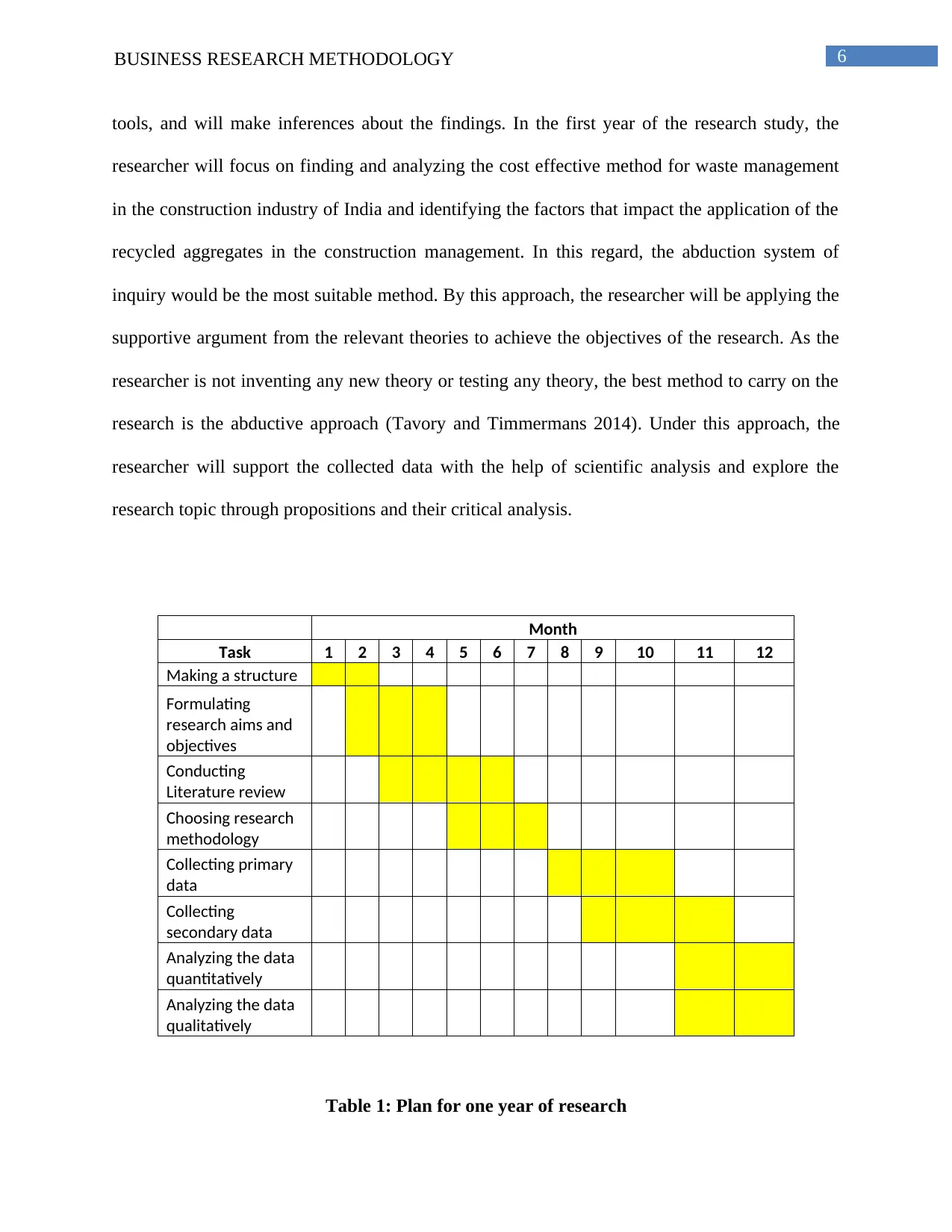
6BUSINESS RESEARCH METHODOLOGY
tools, and will make inferences about the findings. In the first year of the research study, the
researcher will focus on finding and analyzing the cost effective method for waste management
in the construction industry of India and identifying the factors that impact the application of the
recycled aggregates in the construction management. In this regard, the abduction system of
inquiry would be the most suitable method. By this approach, the researcher will be applying the
supportive argument from the relevant theories to achieve the objectives of the research. As the
researcher is not inventing any new theory or testing any theory, the best method to carry on the
research is the abductive approach (Tavory and Timmermans 2014). Under this approach, the
researcher will support the collected data with the help of scientific analysis and explore the
research topic through propositions and their critical analysis.
Month
Task 1 2 3 4 5 6 7 8 9 10 11 12
Making a structure
Formulating
research aims and
objectives
Conducting
Literature review
Choosing research
methodology
Collecting primary
data
Collecting
secondary data
Analyzing the data
quantitatively
Analyzing the data
qualitatively
Table 1: Plan for one year of research
tools, and will make inferences about the findings. In the first year of the research study, the
researcher will focus on finding and analyzing the cost effective method for waste management
in the construction industry of India and identifying the factors that impact the application of the
recycled aggregates in the construction management. In this regard, the abduction system of
inquiry would be the most suitable method. By this approach, the researcher will be applying the
supportive argument from the relevant theories to achieve the objectives of the research. As the
researcher is not inventing any new theory or testing any theory, the best method to carry on the
research is the abductive approach (Tavory and Timmermans 2014). Under this approach, the
researcher will support the collected data with the help of scientific analysis and explore the
research topic through propositions and their critical analysis.
Month
Task 1 2 3 4 5 6 7 8 9 10 11 12
Making a structure
Formulating
research aims and
objectives
Conducting
Literature review
Choosing research
methodology
Collecting primary
data
Collecting
secondary data
Analyzing the data
quantitatively
Analyzing the data
qualitatively
Table 1: Plan for one year of research
Paraphrase This Document
Need a fresh take? Get an instant paraphrase of this document with our AI Paraphraser

7BUSINESS RESEARCH METHODOLOGY
(Created by author)
For doing the research, the researcher will be choosing case studies and combined
strategies approach. In the case studies and combined strategies method, the researcher studies
and analyzes the data based on certain phenomenon, event or organization. Case studies are
helpful in a research by presenting a similar situation like the research topic with the similar
characteristics (Zainal 2017). In this course, the researcher will take interviews of the people
associated with the construction industry and waste management and analyze their response to
get important information. The research approach will involve the people from the construction
industry and waste management in India and the researcher will conduct a survey or interviews
to get information about the research subject and apply either qualitative or quantitative or both
the methods for analysis.
Reference to another relevant research using similar approach
The research by T. Sekar, N. Ganesan and NVN Nampoothiri, ‘Studies on strength
characteristics on utilization of waste materials as coarse aggregate in concrete’ (2011), has
followed the similar approach of research as in the current research. From the study, it is seen
that, the researchers have focused on the utilization of the recycled aggregates in the construction
industry of India and they have adopted the abduction system of inquiry for writing the paper.
The conclusion is drawn based on the propositions made and tested against the observations and
the established theories.
Sequence of methods:
Following the abduction system of inquiry, as stated by Groat and Wang (2015)
(Created by author)
For doing the research, the researcher will be choosing case studies and combined
strategies approach. In the case studies and combined strategies method, the researcher studies
and analyzes the data based on certain phenomenon, event or organization. Case studies are
helpful in a research by presenting a similar situation like the research topic with the similar
characteristics (Zainal 2017). In this course, the researcher will take interviews of the people
associated with the construction industry and waste management and analyze their response to
get important information. The research approach will involve the people from the construction
industry and waste management in India and the researcher will conduct a survey or interviews
to get information about the research subject and apply either qualitative or quantitative or both
the methods for analysis.
Reference to another relevant research using similar approach
The research by T. Sekar, N. Ganesan and NVN Nampoothiri, ‘Studies on strength
characteristics on utilization of waste materials as coarse aggregate in concrete’ (2011), has
followed the similar approach of research as in the current research. From the study, it is seen
that, the researchers have focused on the utilization of the recycled aggregates in the construction
industry of India and they have adopted the abduction system of inquiry for writing the paper.
The conclusion is drawn based on the propositions made and tested against the observations and
the established theories.
Sequence of methods:
Following the abduction system of inquiry, as stated by Groat and Wang (2015)
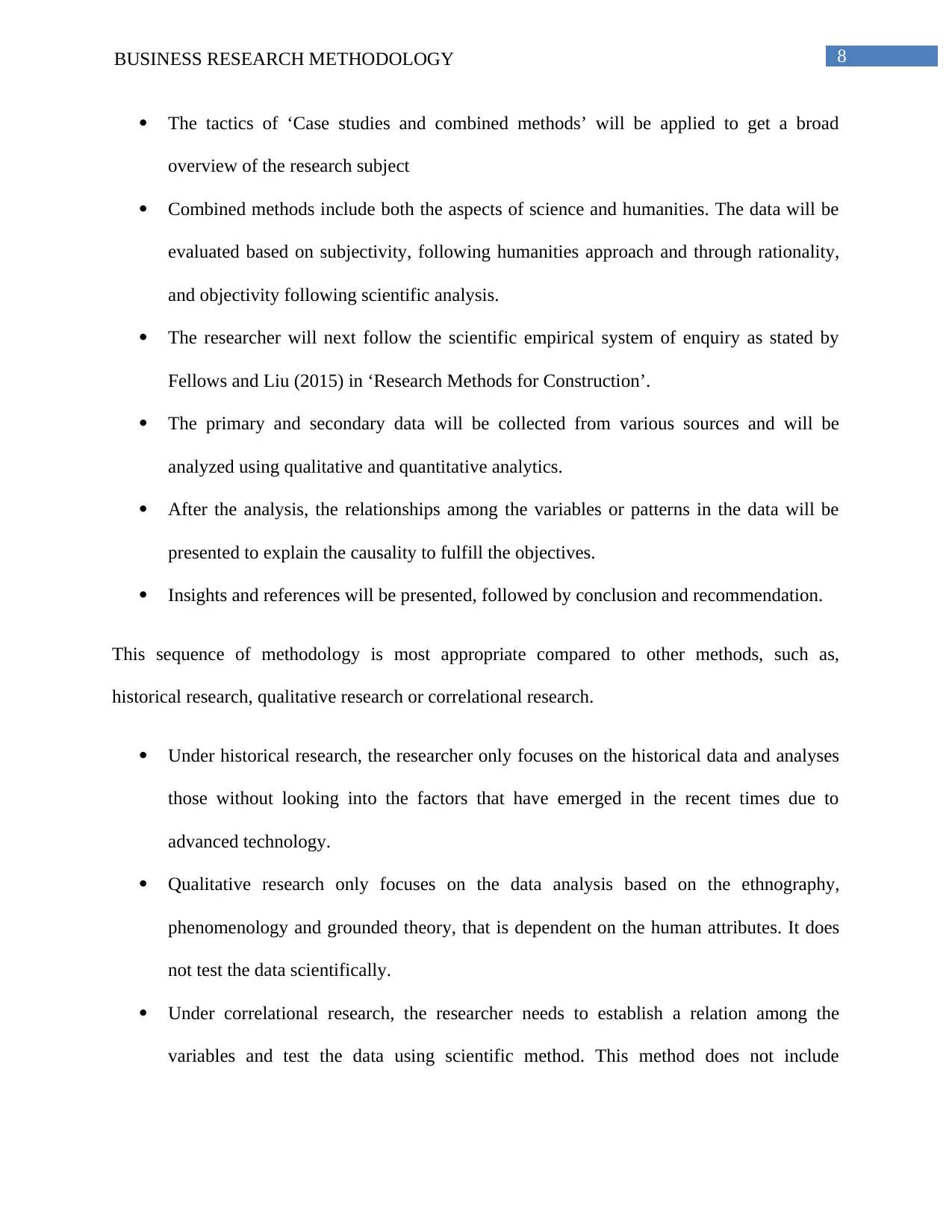
8BUSINESS RESEARCH METHODOLOGY
The tactics of ‘Case studies and combined methods’ will be applied to get a broad
overview of the research subject
Combined methods include both the aspects of science and humanities. The data will be
evaluated based on subjectivity, following humanities approach and through rationality,
and objectivity following scientific analysis.
The researcher will next follow the scientific empirical system of enquiry as stated by
Fellows and Liu (2015) in ‘Research Methods for Construction’.
The primary and secondary data will be collected from various sources and will be
analyzed using qualitative and quantitative analytics.
After the analysis, the relationships among the variables or patterns in the data will be
presented to explain the causality to fulfill the objectives.
Insights and references will be presented, followed by conclusion and recommendation.
This sequence of methodology is most appropriate compared to other methods, such as,
historical research, qualitative research or correlational research.
Under historical research, the researcher only focuses on the historical data and analyses
those without looking into the factors that have emerged in the recent times due to
advanced technology.
Qualitative research only focuses on the data analysis based on the ethnography,
phenomenology and grounded theory, that is dependent on the human attributes. It does
not test the data scientifically.
Under correlational research, the researcher needs to establish a relation among the
variables and test the data using scientific method. This method does not include
The tactics of ‘Case studies and combined methods’ will be applied to get a broad
overview of the research subject
Combined methods include both the aspects of science and humanities. The data will be
evaluated based on subjectivity, following humanities approach and through rationality,
and objectivity following scientific analysis.
The researcher will next follow the scientific empirical system of enquiry as stated by
Fellows and Liu (2015) in ‘Research Methods for Construction’.
The primary and secondary data will be collected from various sources and will be
analyzed using qualitative and quantitative analytics.
After the analysis, the relationships among the variables or patterns in the data will be
presented to explain the causality to fulfill the objectives.
Insights and references will be presented, followed by conclusion and recommendation.
This sequence of methodology is most appropriate compared to other methods, such as,
historical research, qualitative research or correlational research.
Under historical research, the researcher only focuses on the historical data and analyses
those without looking into the factors that have emerged in the recent times due to
advanced technology.
Qualitative research only focuses on the data analysis based on the ethnography,
phenomenology and grounded theory, that is dependent on the human attributes. It does
not test the data scientifically.
Under correlational research, the researcher needs to establish a relation among the
variables and test the data using scientific method. This method does not include
⊘ This is a preview!⊘
Do you want full access?
Subscribe today to unlock all pages.

Trusted by 1+ million students worldwide
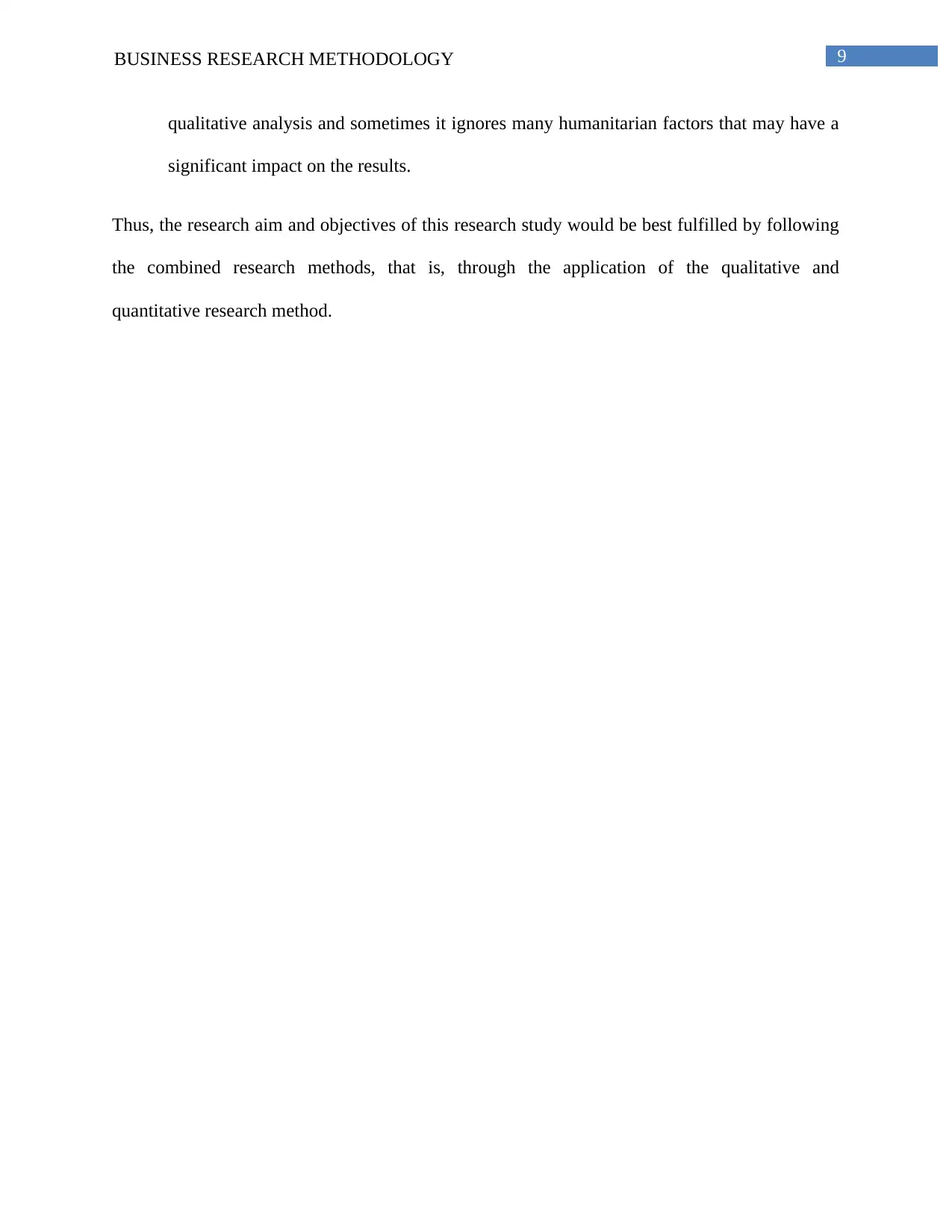
9BUSINESS RESEARCH METHODOLOGY
qualitative analysis and sometimes it ignores many humanitarian factors that may have a
significant impact on the results.
Thus, the research aim and objectives of this research study would be best fulfilled by following
the combined research methods, that is, through the application of the qualitative and
quantitative research method.
qualitative analysis and sometimes it ignores many humanitarian factors that may have a
significant impact on the results.
Thus, the research aim and objectives of this research study would be best fulfilled by following
the combined research methods, that is, through the application of the qualitative and
quantitative research method.
Paraphrase This Document
Need a fresh take? Get an instant paraphrase of this document with our AI Paraphraser

10BUSINESS RESEARCH METHODOLOGY
Section 3
In this project, the researcher will follow the case study and combined strategies for
addressing the research subject. Initially, he needs to submit his research plan and get approval
from his supervisor. Once it is approved, he will start with literature review and choosing the
methodology. He will be designing few interview questions and survey questionnaire to collect
primary data on the recycling and reusing the construction and demolition waste in the
construction management in India. He will be choosing few employees of one major company in
this industry for conducting the survey and interview. After that, he will be collecting secondary
data from various authentic sources, such as, official websites, newspapers, online publications,
journals etc. after collecting the data, the researcher will analyze the data using qualitative and
quantitative methods to achieve his research objectives. Finally, he will present the findings in a
comprehensive manner, establish a link with the research objectives, and present some
recommendations based on that in the concluding chapter of the project.
In this section, the 11 weeks plan for the research will be presented. The plan below
depicts the way that the researcher can follow to complete the entire research within 11 weeks. In
the these 11 weeks, the focus of the researcher will be on the outlining the research, writing the
proposal, getting the approval and proceed with the literature review, data collection and analysis
and presenting the findings by establishing a link with the objecives. The researcher will break
the entire project into small tasks and allocate the time accordingly. The project is expected to
start from March 5, 2018 and will continue for 11 weeks.
Section 3
In this project, the researcher will follow the case study and combined strategies for
addressing the research subject. Initially, he needs to submit his research plan and get approval
from his supervisor. Once it is approved, he will start with literature review and choosing the
methodology. He will be designing few interview questions and survey questionnaire to collect
primary data on the recycling and reusing the construction and demolition waste in the
construction management in India. He will be choosing few employees of one major company in
this industry for conducting the survey and interview. After that, he will be collecting secondary
data from various authentic sources, such as, official websites, newspapers, online publications,
journals etc. after collecting the data, the researcher will analyze the data using qualitative and
quantitative methods to achieve his research objectives. Finally, he will present the findings in a
comprehensive manner, establish a link with the research objectives, and present some
recommendations based on that in the concluding chapter of the project.
In this section, the 11 weeks plan for the research will be presented. The plan below
depicts the way that the researcher can follow to complete the entire research within 11 weeks. In
the these 11 weeks, the focus of the researcher will be on the outlining the research, writing the
proposal, getting the approval and proceed with the literature review, data collection and analysis
and presenting the findings by establishing a link with the objecives. The researcher will break
the entire project into small tasks and allocate the time accordingly. The project is expected to
start from March 5, 2018 and will continue for 11 weeks.
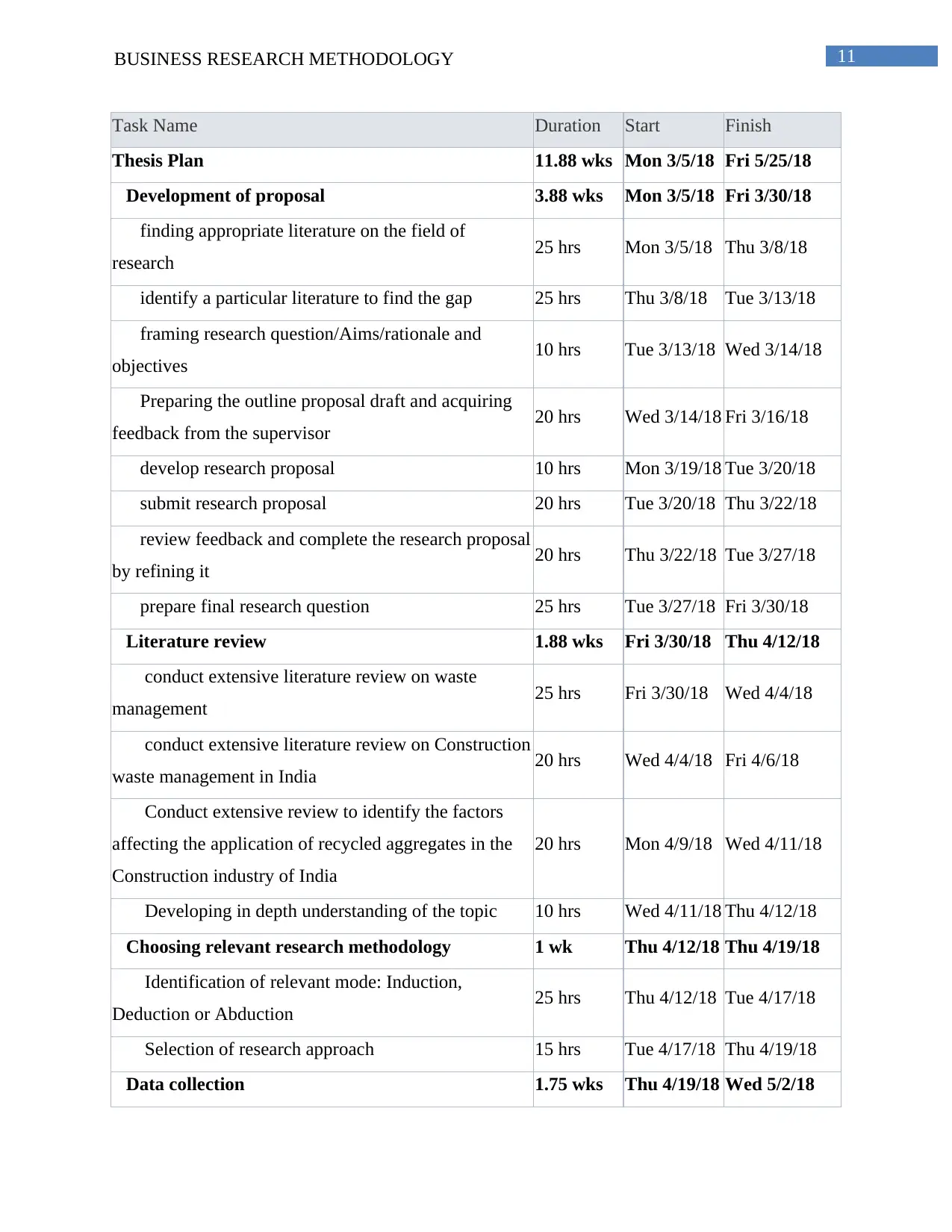
11BUSINESS RESEARCH METHODOLOGY
Task Name Duration Start Finish
Thesis Plan 11.88 wks Mon 3/5/18 Fri 5/25/18
Development of proposal 3.88 wks Mon 3/5/18 Fri 3/30/18
finding appropriate literature on the field of
research 25 hrs Mon 3/5/18 Thu 3/8/18
identify a particular literature to find the gap 25 hrs Thu 3/8/18 Tue 3/13/18
framing research question/Aims/rationale and
objectives 10 hrs Tue 3/13/18 Wed 3/14/18
Preparing the outline proposal draft and acquiring
feedback from the supervisor 20 hrs Wed 3/14/18 Fri 3/16/18
develop research proposal 10 hrs Mon 3/19/18 Tue 3/20/18
submit research proposal 20 hrs Tue 3/20/18 Thu 3/22/18
review feedback and complete the research proposal
by refining it 20 hrs Thu 3/22/18 Tue 3/27/18
prepare final research question 25 hrs Tue 3/27/18 Fri 3/30/18
Literature review 1.88 wks Fri 3/30/18 Thu 4/12/18
conduct extensive literature review on waste
management 25 hrs Fri 3/30/18 Wed 4/4/18
conduct extensive literature review on Construction
waste management in India 20 hrs Wed 4/4/18 Fri 4/6/18
Conduct extensive review to identify the factors
affecting the application of recycled aggregates in the
Construction industry of India
20 hrs Mon 4/9/18 Wed 4/11/18
Developing in depth understanding of the topic 10 hrs Wed 4/11/18 Thu 4/12/18
Choosing relevant research methodology 1 wk Thu 4/12/18 Thu 4/19/18
Identification of relevant mode: Induction,
Deduction or Abduction 25 hrs Thu 4/12/18 Tue 4/17/18
Selection of research approach 15 hrs Tue 4/17/18 Thu 4/19/18
Data collection 1.75 wks Thu 4/19/18 Wed 5/2/18
Task Name Duration Start Finish
Thesis Plan 11.88 wks Mon 3/5/18 Fri 5/25/18
Development of proposal 3.88 wks Mon 3/5/18 Fri 3/30/18
finding appropriate literature on the field of
research 25 hrs Mon 3/5/18 Thu 3/8/18
identify a particular literature to find the gap 25 hrs Thu 3/8/18 Tue 3/13/18
framing research question/Aims/rationale and
objectives 10 hrs Tue 3/13/18 Wed 3/14/18
Preparing the outline proposal draft and acquiring
feedback from the supervisor 20 hrs Wed 3/14/18 Fri 3/16/18
develop research proposal 10 hrs Mon 3/19/18 Tue 3/20/18
submit research proposal 20 hrs Tue 3/20/18 Thu 3/22/18
review feedback and complete the research proposal
by refining it 20 hrs Thu 3/22/18 Tue 3/27/18
prepare final research question 25 hrs Tue 3/27/18 Fri 3/30/18
Literature review 1.88 wks Fri 3/30/18 Thu 4/12/18
conduct extensive literature review on waste
management 25 hrs Fri 3/30/18 Wed 4/4/18
conduct extensive literature review on Construction
waste management in India 20 hrs Wed 4/4/18 Fri 4/6/18
Conduct extensive review to identify the factors
affecting the application of recycled aggregates in the
Construction industry of India
20 hrs Mon 4/9/18 Wed 4/11/18
Developing in depth understanding of the topic 10 hrs Wed 4/11/18 Thu 4/12/18
Choosing relevant research methodology 1 wk Thu 4/12/18 Thu 4/19/18
Identification of relevant mode: Induction,
Deduction or Abduction 25 hrs Thu 4/12/18 Tue 4/17/18
Selection of research approach 15 hrs Tue 4/17/18 Thu 4/19/18
Data collection 1.75 wks Thu 4/19/18 Wed 5/2/18
⊘ This is a preview!⊘
Do you want full access?
Subscribe today to unlock all pages.

Trusted by 1+ million students worldwide
1 out of 17
Related Documents
Your All-in-One AI-Powered Toolkit for Academic Success.
+13062052269
info@desklib.com
Available 24*7 on WhatsApp / Email
![[object Object]](/_next/static/media/star-bottom.7253800d.svg)
Unlock your academic potential
Copyright © 2020–2025 A2Z Services. All Rights Reserved. Developed and managed by ZUCOL.





